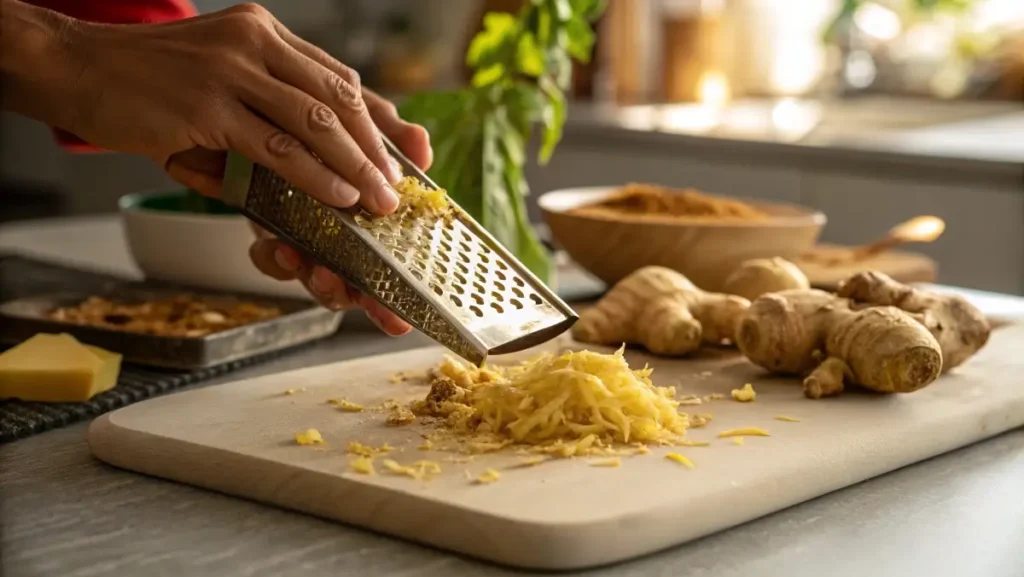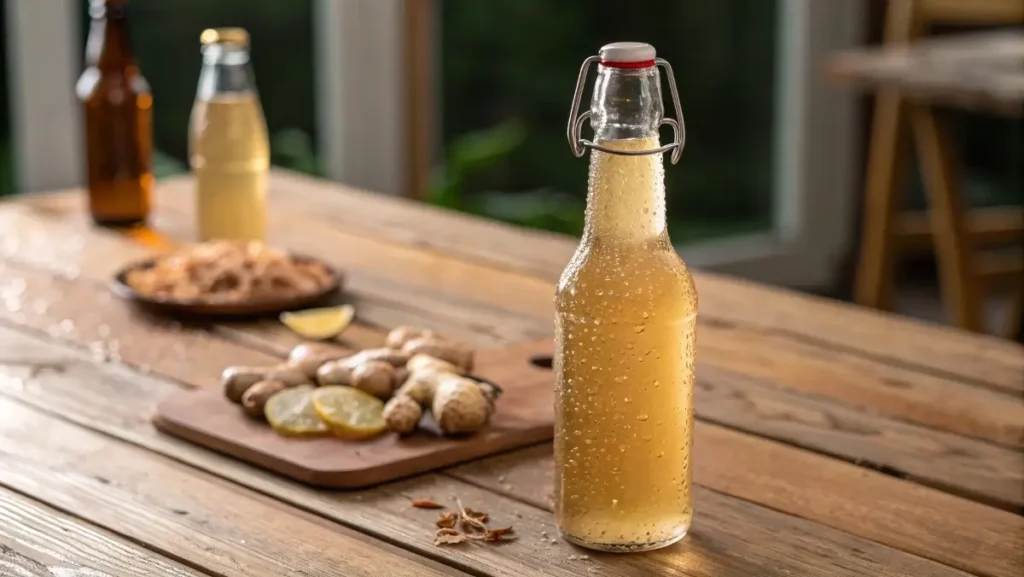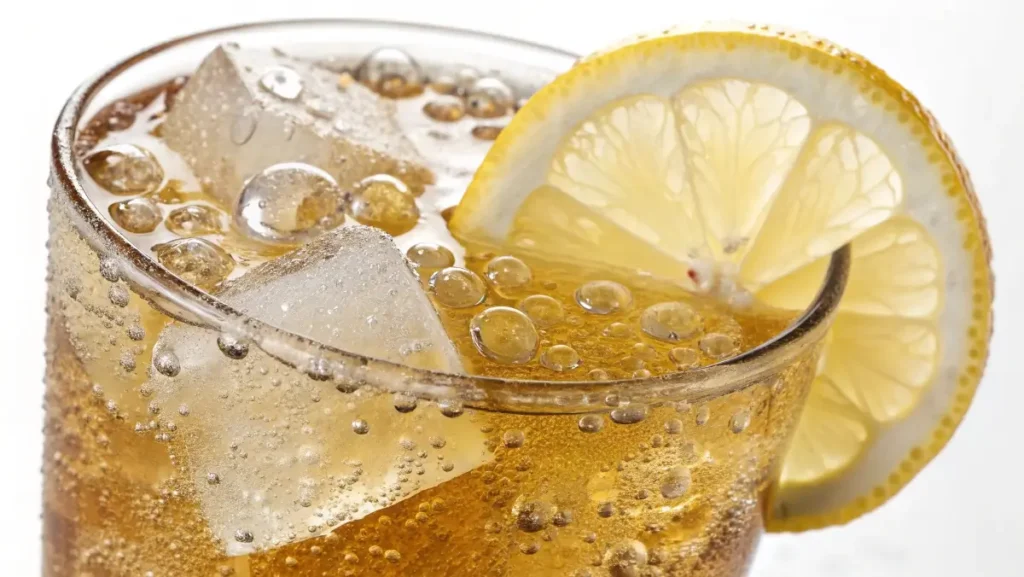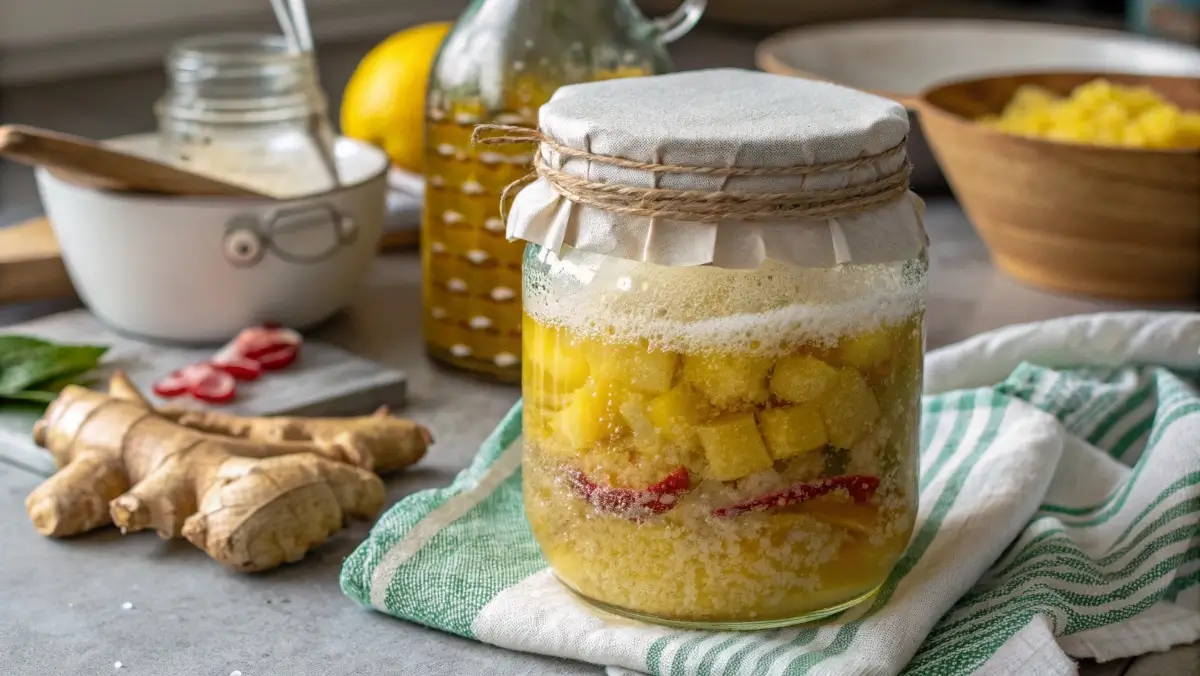Ginger Bug Recipe – The Complete Guide to Making Your Own Natural Fermentation Starter
Fermentation has been part of human food culture for centuries. One of the easiest ways to explore it is with a ginger bug recipe.
A ginger bug is a simple mix of ginger, sugar, and water that captures wild yeast and good bacteria. These microorganisms turn sugar into bubbles and probiotics, creating a healthy and naturally fizzy drink starter.
Whether you want to make ginger beer, fruit soda, or try your hand at other homemade ferments, a ginger bug is a great first step. It’s cheap, requires no fancy tools, and is satisfying to watch come alive.
Discover great ideas like homemade energy drink recipe to pair with your creations.
Table of Contents
Understanding the Ginger Bug
What is a Ginger Bug and Why You Should Make One
A ginger bug is a naturally fermented culture made from fresh ginger root, sugar, and water. It captures wild yeast and friendly bacteria from the ginger skin and your environment.
These microbes feed on sugar, producing carbon dioxide for fizz and probiotics for gut health. Every batch is unique because the microorganisms come from your local surroundings.
People make ginger bugs because they’re versatile, easy to care for, and inexpensive. A small daily feeding keeps them active and ready for drink-making.
The Science Behind Ginger Bug Fermentation
When you start a ginger bug, you’re creating a small ecosystem. The ginger provides nutrients and wild microbes, while sugar feeds them.
The yeast turns sugar into bubbles and a little alcohol. Then, bacteria convert some alcohol into tangy acids. This balance of yeast and bacteria is similar to what you find in kombucha or sourdough.
Because it’s a natural process, no two ginger-bugs are exactly alike. Each develops its own flavor and activity level based on your ingredients and environment.
Essential Ingredients for a Ginger Bug Recipe
Choosing the Right Ginger: Fresh vs. Dried
For a healthy ginger bug recipe, fresh ginger root is best. It contains live wild yeast and beneficial bacteria on its skin, which help kickstart fermentation. Always choose ginger that’s firm, unpeeled, and free from mold.
Organic ginger is ideal because it hasn’t been treated with chemicals that could slow fermentation. Wash lightly but avoid scrubbing too hard—you want to keep those natural microbes intact.
Dried ginger, on the other hand, won’t work well for starting a ginger-bug. It has lost much of its natural microbial life during processing. You can use it later to flavor drinks, but not for creating the starter itself.

The Role of Sugar in Fermentation
Sugar isn’t just for sweetness—it’s the main food source for the wild yeast and bacteria in your ginger bug recipe. As they consume sugar, they release carbon dioxide and organic acids.
You can use white sugar for consistent results. Light brown sugar or raw cane sugar can also work, adding trace minerals and a subtle molasses flavor. Avoid artificial sweeteners, as they can’t be fermented by the microbes.
The right balance of sugar is important. Too little and your culture may starve; too much and you risk over-fermentation. A tablespoon per feeding is the sweet spot for most ginger-bugs.
Learn more about homemade rhubarb jam for another tasty kitchen project using natural ingredients.
Step-by-Step Ginger Bug Recipe
Day 1: Mixing the Starter
To start your ginger bug recipe, combine 2 tablespoons of grated fresh ginger, 2 tablespoons of sugar, and 1 cup of non-chlorinated water in a clean glass jar.
Stir well with a wooden spoon. Avoid metal utensils if possible, as they can react with acidic fermentations. Cover the jar with a breathable cloth or coffee filter, securing it with a rubber band.
Place the jar in a warm spot, around 70–80°F (21–27°C). Fermentation is slower in cooler environments.
Daily Feeding Schedule
Every day, for the next 5–7 days, feed your bug 1 tablespoon of grated ginger and 1 tablespoon of sugar. Stir well after each feeding to mix in air and encourage microbial growth.
Here’s a quick reference:
| Day | Feeding | Signs of Activity |
|---|---|---|
| 1 | 2 tbsp ginger + 2 tbsp sugar | Cloudy water, ginger floating |
| 2 | 1 tbsp ginger + 1 tbsp sugar | Small bubbles, mild ginger smell |
| 3 | 1 tbsp ginger + 1 tbsp sugar | More bubbles, yeasty aroma |
| 4 | 1 tbsp ginger + 1 tbsp sugar | Foam layer, strong fizz |
| 5 | 1 tbsp ginger + 1 tbsp sugar | Ready to use in recipes |
| 6–7 | Optional feeding | Keep it active until use |
Knowing When It’s Ready
Your ginger bug is ready when you see lots of bubbles rising to the surface and hear a faint fizz when you stir. The smell must be pleasantly sweet and slightly tangy, not moldy or rotten.
If there’s little to no activity after a week, check your water source and ginger quality. Chlorine or treated ginger can slow the process.
Don’t miss our homemade Virgin Pina Colada Recipe for a perfect first drink to ferment with your fresh ginger-bug.
How to Use Your Ginger Bug
Making Homemade Ginger Beer
One of the most popular uses for a ginger bug recipe is ginger beer. To make it, mix ¼ cup of active ginger-bug liquid with 4 cups of sweetened ginger tea.
Pour into swing-top bottles, leaving about 1–2 inches of headspace. Let the bottles sit at room temperature for 2–4 days, then refrigerate. The result is a naturally carbonated, tangy-sweet drink with a ginger kick.
Always open bottles carefully, as natural carbonation can be strong.
Creating Fruity Homemade Sodas
You can also use your ginger bug to turn fruit juice into a naturally fizzy soda. Mix ¼ cup of starter with 4 cups of fresh juice, straining out any pulp for a smoother drink.
Bottle the mixture and let it ferment for 1–3 days, adjusting the time based on your preferred level of carbonation. Once ready, chill to slow fermentation and enjoy a refreshing homemade soda.
This method works beautifully with apple, pineapple, mango, or berry juices.

Experimenting with Herbal and Floral Flavors
You’re not limited to ginger and fruit. Use your ginger bug recipe to ferment herbal teas, hibiscus infusions, or even lavender lemonade.
Start with sweetened tea or infusion, add your ginger bug liquid, and follow the same bottling process. The result is a custom, probiotic-rich beverage that’s uniquely yours.
Looking for inspiration? Try Easy Mocktails for a tangy, festive soda base using your ginger-bug.
Caring for and Maintaining Your Ginger Bug
Daily and Weekly Feeding Tips
To keep your ginger bug recipe culture healthy, feed it regularly. If you’re using it often, daily feedings work best—1 tablespoon of grated ginger and 1 tablespoon of sugar each day.
If you’re brewing less often, you can store the jar in the fridge and feed it once a week. Chilling slows microbial activity, so your bug won’t consume sugar as quickly.
Always stir after feeding to oxygenate the culture and prevent surface mold.
Storing Your Ginger Bug for Short and Long Breaks
If you’re taking a break from brewing, you can store the ginger bug in the refrigerator for up to a month without feeding. When you’re ready to use it again, take it out, feed it daily for 2–3 days, and watch for active bubbling before brewing.
For extended breaks, you can dehydrate your ginger bug. Simply spread a thin layer of the strained starter onto parchment paper, let it dry completely, and store it in an airtight container. To reactivate, dissolve the dried flakes in water, then add fresh ginger and sugar, feeding daily until it becomes bubbly and active again.
Signs Your Ginger Bug Needs Attention
A healthy bug smells fresh, sweet, and slightly tangy. If it develops a strong vinegar odor, slimy texture, or mold spots, it’s time to start over.
Lack of bubbles can mean it needs more warmth, fresher ginger, or non-chlorinated water. Adjust one factor at a time to bring it back to life.
Check out Peach Blueberry Cobbler for a flavorful mix-in to your next ginger-bug soda creation.
Troubleshooting Common Ginger Bug Problems
No Bubbles or Signs of Fermentation
If your ginger bug recipe isn’t bubbling after a few days, don’t panic. First, check the temperature—cool environments slow fermentation. Aim for 70–80°F (21–27°C).
Next, consider your water. Chlorinated tap water can harm wild yeast and bacteria. Try filtered or spring water instead.
Finally, use fresh, unpeeled ginger. Old or treated ginger often has fewer live microbes to start the process.
Strange Odors or Mold Growth
A healthy ginger bug should smell sweet and slightly tangy. If you notice a rotten, cheesy, or moldy smell, discard it and start fresh. Mold often appears if the surface is left dry or uncovered too tightly.
Prevent mold by stirring daily, keeping the ginger submerged, and using a breathable cover like a cloth or coffee filter.
Too Much Foam or Explosive Bottles
If your ginger bug drinks are overly fizzy or bottles explode, you’re fermenting too long or at too high a temperature. Reduce bottling time and always refrigerate once the desired fizz is reached.
Opening bottles over the sink and “burping” them daily can help avoid accidents.
Health Benefits of Ginger Bug Drinks
Probiotic Power for Gut Health
A well-made ginger bug recipe produces a starter packed with beneficial bacteria and yeast. These probiotics can help support a balanced gut microbiome, which plays a role in digestion, nutrient absorption, and immune function.
Drinking ginger-bug-based beverages regularly may help increase your intake of natural probiotics without relying solely on supplements.

Digestive and Anti-Inflammatory Properties
Ginger itself has a long history of use as a digestive aid. It may help reduce nausea, improve stomach motility, and ease bloating. Combined with the fermentation process, your ginger-bug drink becomes both flavorful and functional.
Some studies also link ginger to anti-inflammatory benefits, which may support joint health and overall well-being.
Natural Energy and Hydration Boost
Fermented ginger bug drinks often contain small amounts of natural B vitamins produced by the yeast. These may provide a mild energy lift without caffeine.
When brewed with fresh fruit juices or herbal infusions, these beverages also help keep you hydrated in a refreshing, flavorful way.
Discover great ideas like The Best Dirty Soda Recipes for another health-conscious homemade drink base.
Conclusion
Mastering the ginger bug recipe opens the door to endless homemade, probiotic-rich beverages. From classic ginger beer to fruit sodas and herbal infusions, this simple starter offers flavor, fizz, and health benefits in every glass.
With just ginger, sugar, and water, you can nurture a living culture that not only enhances your drinks but also supports your gut health. Whether you’re a fermentation beginner or a seasoned homebrewer, caring for your ginger bug is straightforward — and the rewards are delicious.
So, grab some fresh ginger, start your jar, and let nature’s wild fermentation transform your kitchen into a craft beverage lab.
Looking for inspiration? Try Delicious Alcohol-Free Drinks to create a crisp, refreshing soda base with your ginger-bug.
FAQs
How do I make a ginger bug?
To make a ginger bug, mix grated fresh ginger, sugar, and non-chlorinated water in a clean jar. Feed it daily with more ginger and sugar until it becomes bubbly and active. You can follow the step-by-step method in the main ginger bug recipe section above.
Can you drink straight ginger bug?
You technically can, but it’s not the best idea. The liquid is highly concentrated, tangy, and may be too strong for some stomachs. It’s best to use it as a starter to ferment other beverages.
How do you use your ginger bug?
Your ginger-bug can be used to make naturally carbonated drinks like ginger beer, fruit sodas, herbal tonics, and more. Simply add a portion of the active liquid to sweetened tea, juice, or herbal infusions.
Is ginger bug the same as kombucha?
No. Kombucha uses a SCOBY (symbiotic culture of bacteria and yeast) and tea as its base, while a ginger-bug uses wild yeast from ginger and sugar. Both are fermented, probiotic-rich drinks but have different flavors and fermentation processes.
Is ginger bug good for your gut?
Yes, when made properly, ginger bug drinks contain beneficial bacteria and yeast that can help support gut health and digestion.
Is ginger bug just yeast?
Not exactly. A ginger-bug contains both wild yeast and beneficial bacteria, along with the natural flavors and compounds from fresh ginger. This combination gives it its probiotic potential and unique taste.

